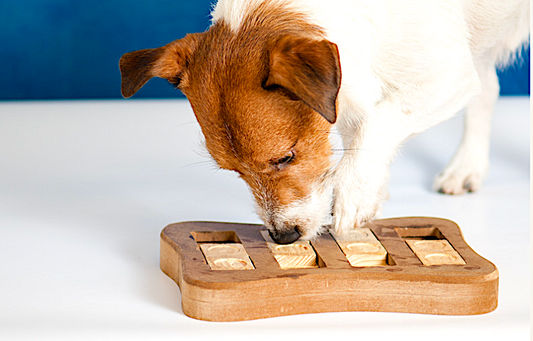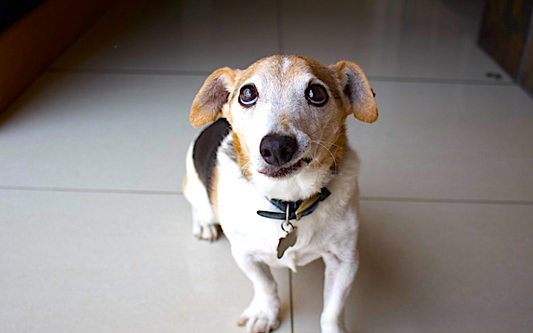No, your dog is never too old to walk. Now that we’ve established that, there’s a lot to discuss.
We’re going to talk about things like:
- Can you walk a dog too much?
- How far should you walk an old dog?
- What to do if your old dog won’t walk
- How to help a dog with mobility issues
Why is it so important to walk your old dog?
Sadly, many senior dogs don’t get out much, some are only let out to pee and poop, and the rest of the time they’re lying in their beds. Sometimes it’s mobility that is the issue, but we’ll get to that later.
- Dogs need a walk not only for much needed physical exercise, but for mental stimulation as well.
- Dogs who don’t go out for walks end up bored, depressed, frustrated and even destructive.
- They are likely to gain weight, which can cause health issues like diabetes, and carrying extra weight makes sore joints hurt even more. That makes walking more painful so they can’t go out and the vicious cycle continues.
- It’s an easy form of exercise that can be done to suit your dog’s pace.
- It's a great opportunity for your dog to socialize.
- Walking actually helps with arthritis and joint pain (according to an article on the petmd website, “Light activities such as walking and swimming help strengthen muscles, keep ligaments and tendons flexible, prevent obesity and circulate blood to stiff joints").
- It's a chance to spend quality time together with your dog and a nice way to bond.
- It’s just not fair to keep your dog cooped up all day.

Can you walk a dog too much?
Yes absolutely. Have you ever heard of weekend warriors? These are the people who don’t walk their dog much during the week because they’re busy or at work, but on the weekend take them for hikes that last hours. Okay maybe not hours, but longer than their dog can handle.
The number of walks a day, how far you walk, and the intensity of those walks will depend on your dog’s ability. You can’t judge by age because there are plenty of dogs who are “technically” seniors but they’re just as energetic and ready to go as they were in their younger years.
It’s also better to take shorter, more frequent walks than one longer walk a day. It staves off boredom, provides them with stimulation and breaks up the day. Walking dogs more often can also help stimulate their appetite, which is important if your dog isn’t eating as well as he/she should.
NOTE: If your dog has arthritis or other joint pain, please consult with your vet about the frequency and intensity of your walks.
How do I get my old dog to walk if he doesn’t want to?
First let’s look at some of the reasons why your dog doesn’t want to go for a walk. Then, we’ll see what to do about it.
NOTE: Never force your dog to walk.
Reasons why your dog may not want to go for a walk
- Pain - Arthritis, hip dysplasia and the like are not uncommon in old dogs. Left untreated or not as well managed as it could be, pain is a big reason why your dog would rather stay on his bed. To learn more about arthritis read this “Arthritis: How to Recognize and Manage the Condition.”
- Fear/anxiety- If your dog suddenly decides he doesn’t want to walk, it’s possible he’s afraid. Something could have happened you weren’t even aware of. Maybe he’s been losing his hearing, and is having trouble adapting outside. If your old dog is a recent adoptee, he may be nervous out there in the world. We don’t often know a dog’s history or what his life was like before he was surrendered.
- Never been out before - Your old dog could have spent years breeding in a puppy farm (my sweet Saffy spent 8 years in a cage) or lived his life at the end of a chain. These poor souls have no idea what it’s like to be loved and cared for, never mind how to cope with a walk.

- Uncomfortable walking gear - Whether it’s a coat that’s too restrictive, a harness that doesn’t fit properly, or a collar that causes pain, if your dog is uncomfortable, what are the chances he’s going to want to go out.
- What’s the weather like? - Is it snowing and the sidewalks are covered in salt that is burning his paws? Are the pavements so hot you can fry an egg, never mind his feet? Is he feeling the cold more now that he’s older, but doesn’t have a coat or sweater for protection?
- Does he have heart problems? - Shortness of breath due to heart issues can make walking a struggle…so he doesn’t bother.
- How’s his weight? - If your dog is overweight, walking will be challenging and uncomfortable. When I adopted my dog Red, she was around 8 years old and obese. She was so fat her stomach almost touched the ground, and couldn’t walk more than a few steps without having to rest. Once she was put on a proper diet and started to lose weight, walking became so much easier and she loved it!
How to get your dog interested in going for walks
A lot of this depends on the reason why your dog isn’t interested in walks. This section will have lots of tips and advice, so if one thing doesn’t work you have lots of others to try.
- Tip #1 - If your dog is in pain from an injured paw or the beginnings/flare up of arthritis, a trip to the vet is your priority. They may recommend pain medication that should help get your dog's mobility. There are also lots of natural options to consider – “What is the Best Natural Arthritis Pain Relief for Dogs.” Be sure to consult with your vet before trying something new.
- Tip #2 - A dog that has never been out due to neglect or living in a puppy mill for example, will take time getting used to wearing a leash and collar. Start off slowly in the house by attaching the leash to the collar and let him walk around the house like that. Do it for short periods to get him used to it, then pick up the leash and walk him in the house. Next you’ll want to do that in the backyard. Don’t move on to the next step until he’s comfortable. If he’s fearful rushing can set back your progress, so it’s better to take it slowly.
- Tip #3 - Go out the back door instead of the front. Yes, that may be all that’s needed to get him interested.
- Tip #4 - Take your dog outside when it’s most likely to be quiet. If getting him outside the door is an achievement, give him a reward. If he takes a step in what could be the beginning of a walk, reward him again. Your next goal could be walking to the top of the driveway, then the sidewalk…You want to create positive associations with the collar, leash, being outside and taking a few steps. If he turns and is ready to come in, don’t give him treats, as that will reward him for going home. Go in the house without saying a word and try again later.
- Tip #5 - Make sure his harness fits well and is comfortable, and check for sharp pieces or thick stitching that could be itchy.

- Tip #6 - Take him out, come back in then take him out again. That small move can make a big difference by breaking the “same old same old” routine.
- Tip #7 - If you’ve been walking the same route for years, how about a change? Give him new sites to see and new smells to sniff. We all need a change of scenery.
- Tip #8 - It would be nice to combine our cardio with a dog walk, but you need to go at his pace not yours.
- Tip #9 - Has he not wanted to leave the house, or does he want to walk but refuses to go where you want? A few years ago we adopted our dog Jack, and although he was always ready to go for a walk, he would not walk where we wanted. We finally realized it was his way or no way, so that’s the way it is. We don’t have a problem with that, and he looks forward to the walks.
- Tip #10 - Watch your dog’s reaction and when he’s had enough then head back home. Better to take him out 3 or 4 times a day for 10 or 15 minutes each than one long walk for an hour. It can be too hard on his joints, and once a day leaves many hours for him to be bored.
- Tip #11 - If your dog refuses to walk in the rain, maybe a raincoat will help. If it’s cold, a sweater and maybe even a coat can make all the difference. Snow means salt so booties or paw wax can help.
- Tip #12 - Take breaks, even on short walks and be sure to bring water. Nothing wrong with spending some time sitting in the park on a lovely summer day!
- Tip #13 - If your dog is experiencing vision/hearing loss, keep to familiar surroundings. You may have been trying new routes and the unfamiliar is causing him anxiety. Walking the areas he knows will keep him comfortable. It’s also important to be aware of what’s going on around you. Sudden movements such as a bicycle flying past can be stressful. If you see something that can cause anxiety, move him off the path if possible and stand in front of him so he doesn’t notice. You can also distract him by petting him or giving him a treat.
- Tip #14 - Be mindful of where you’re walking the dog. Even though they may be short walks are they on rocky or uneven surfaces? Are they on a path with fallen branches and inclines? Grass with holes he can hurt his foot in? Try a level smooth sidewalk instead and see if that makes him more willing to go out.
What else can help your old dog on his walks?
Mobility aids. That’s right, there are several options that will make walking easier, and when it’s easier, your old dog is more likely to want to and be able to do it.
The pet stroller - This is my absolute favorite. It has been the biggest help to me, in ways almost too numerous to mention. I used to take my old dog Red out for a few short walks a day, but on the weekends when the weather was nice, we liked to take our other dog Jack to run around the beach. Although she was small enough to carry even little dogs get heavy after a short while, so the stroller was the perfect solution. She would walk for a few minutes, then I would put her in the stroller so we could keep going. It meant she was always included in our outings, have the chance to get some exercise, but not overdo it. Whether you have a senior dog who can’t walk as far as he used to or a dog recovering from illness or surgery and is only allowed 5 minute walks, you can’t find anything better than a pet stroller.
VITAL VET RECOMMENDED PRODUCT LINKS:
- 2-in-1 Pet stroller and trailer
- 5-in-1 small dog and cat stroller and carrier
- X-large pet stroller for up to 110 lbs
- Extra-heavy duty wagon for up to 265 lbs
Dog wheelchair - Wheelchairs can help dogs with:
- Hip Dysplasia
- Arthritis
- Paralysis
- DM
- IVDD
- Neurological Issues
- Surgical Recovery
- Injuries
- Improve Balance and Stability
This list was taken from the Handicapped Pets website.
VITAL VET RECOMMENDED PRODUCT LINKS AND RESOURCES:
Dog boots - Boots are a wonderful solution for dogs that drag their feet due to join pain, or are unsteady on certain surfaces.
VITAL VET RECOMMENDED PRODUCT LINKS AND RESOURCES:
- Ruff Wear Boots
- Muttluk Boots
- Thera-Paw Padded Boots
- Keeping old, injured, and unstable pets safe at home
- Devices for pets who are knuckling or dragging
Splints and leg supports - Designed to support front or back legs, these splints and leg supports are a tremendous help for dogs dealing with conditions such as osteoarthritis, degenerative joint disease, and soft tissue injuries to name just a few. Velcro straps are used for adjusting, padding on the inside ensures your dog is comfortable, and non-slip pads on the bottom keeps him stable and sure footed.
VITAL VET RECOMMENDED PRODUCT LINKS AND RESOURCES:
- Light, adjustable wrist supports
- Wrist and and supports for dogs
- Thermal wrist supports
- Adjustable wrist braces with moderate stability
- Wraps and braces for wrist and ankle injuries
- Why are custom braces important for dogs
Dog support sling/harness - The sling is another mobility aid you will find useful if your dog is having trouble walking. Since I only needed a sling for 2 or 3 months, I cut up an old t-shirt and used that for my 9lb dog. However there plenty of “proper” slings and harnesses to choose from. One brand many senior dog parents love is the Help ‘Em Up Harness, and another very popular one is the GingerLead.
VITAL VET RECOMMENDED PRODUCT LINKS AND RESOURCES:
Link: https://caringforaseniordog.com/is-your-dog-too-old-to-walk-heres-how-to-know/





